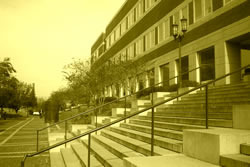 |
ENGL 4400/5400 |
 |
|
November 8th: Color, Color, Color
It Turns Me Upside Down
Color, Color, Color
It's Like a Merry-Go-Round
...Color is Magic
Announcements
- Soledad O'Brien: “Diversity: On TV, Behind the Scenes and in Our Lives”
Thurs., 11/10 @ 7:30 pm
Students Union, Multipurpose Room
- 11/11/11 is Veterans Day
- UFC on Fox Sat., Nov. 12th @ 9:00 pm
- UFC 139 Sat., Nov. 19th @ 9:00 pm
Plan for the Day
Tonight we're going to discuss color. That's right. All the colors in the rainbow and those in between. Ok, we won't go that far, but I want you to consider what makes color important to information design.
Also, many students start to get sick this time of year. If you're coughing, sniffling, or blowing your nose constantly, please reconsider if you're able to participate in class tonight. Not only is coughing distracting, but it spreads germs!
Perception, Culture, Rhetoric
Color perception is an interesting subject that deals with physiological responses. While I don't expect you to be well versed in the anatomy of the eye, there are several terms you should know:
- visible spectrum (p. 248): "a small range of wavelengths between 700 and 400 nanometers (nm)" in which humans can perceive light.
- hue (p. 249): wavelengths of light that cause us to perceive different colors.
- saturation (p. 250):
perception of the purity of color.
- unsaturation (p. 250): a mixture of colors.
- brightness (p. 250): perception of the intensity of light that is transmitted or reflected from a surface.
- tristimulus (p. 249): human perception of colors based on the mixture of perception of the three types of cones in the eye, red, green, and blue.
- ganglion cells (p. 249): the nerves that help distinguish between colors.
- additive primary colors (p. 250): red, green, and blue.
- cyan...it's not the pepper; pronounced cy-an.
- complementary colors (p. 250): two colors directly opposite from each other on the 360-degree color wheel.
- analogous colors (p. 250): "colors close together on the same wheel."
- Color Temperature (p. 251): obviously, this is related to our feelings associated with various colors.
- warm colors: colors naturally brighter at the same level of saturation (i.e. red and yellow).
- cool colors: colors not as bright as warm colors at the same saturation (i.e. green and blue).
- color vision deficiency (p. 252): limitation in perceiving color differences.
So you've perceived the colors. Now what? Well, what can be said about color from cultural and rhetorical perspectives? In groups of 2 or 3, search or recall from your perspective the cultural and rhetorical significance of the following colors:
- red
- orange
- yellow
- green
- blue
- indigo and violet
Look at that. The above 7 colors in 6 categories match the number of rows in class...
Now, turn to page 272 in your textbook. Read Exercise #2. In your groups of 2 or 3, based on your rows, look at the following web pages and think about the questions asked.
Have one of your group members post this on his or her web pages, but all of you in the group should link to it. Call it something obvious, such as "11/08/2010 Web site Color Scheme Discussion."
Now, let's go over some more of the designing with color issues the book discusses. After that discussion, let's look at the differences in Robin Williams' book.
Matching Colors
I know this is a peculiarity of mine, but color matching is really ingrained racism of a culture. Let me explain...
Robin Williams Ch. 7: Using Color
Well, Williams is certainly colorful. What does she have to say about color?
Ethics and Visuals
Let's jump back to last week's "stuff."
When creating visuals or, more likely, manipulating visuals, make sure you aren't distorting reality. I know we all remember Dove's Campaign for Beauty model's metamorphosis. Anyone know of other distortions?
-
Ever heard of "Hitler's Pope"?
Apparently, he never met Hitler, but this
picture, through juxtapositioning, makes a case.
-
This is typical of Washington, DC protests--remember, the camera "frames"
the shots. I do realize this isn't Washington, DC, but it's typical of protests I've seen where the media, because of the limited camera view, make the crowd look bigger.
-
Political photo doctoring or, more accurately, Orwellian propaganda.
While the above might seem like extreme cases, even minor touch ups can be unethical as the book points out.
Photoshop And Mischievous Behavior
Don't forget to do a little digital graffiti if you didn't finish last week. Use the "Clone Stamp Tool" or, if that's beneath you, try out the lasso tool.
This assignments are part of your Web page grade, so please don't put up anything that will embarrass you...or me!
Next Week
Make sure you read Chapter 9 in Document Design, which is the last reading of the semester. We'll be discussing extra-textual elements next week.
Also, those of you in the 5182 section have projects due next week.
....
|
